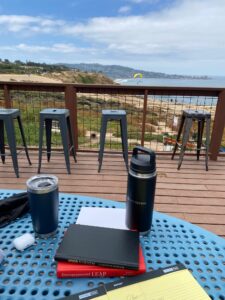By Coleman Cox; A detailed walkthrough of our pipeline management and investment analysis process...
The Power of Intention and the Vintage Vivid Vision

By Coleman Cox
March 29, 2024
When deciding to make the leap into entrepreneurship and start my own business, I knew I needed a plan; a detailed roadmap in front of me and on paper, if only for my own sanity to give me comfort that I’d fully thought through this major decision, and was happy with the direction. Going into business with a partner made this doubly important to ensure we had the same vision for the company.
I’ve never been a fly-by-the-seat-of-my-pants type person. I played competitive baseball through college, and would map out my workout schedules ahead of every off-season. How often would I run, lift lower body, lift upper body, play long toss, go to the batting cage, take ground balls, etc. The up-front process of mapping this out was extremely diligent, and well thought through – it took hours of focused effort to create. But from there on out, I knew exactly what direction I was heading and what I was focused on. I knew I just had to go out and execute consistently and I would be successful.
I applied the same process to some major tests I’ve taken in my professional career while working full time (CPA and CFA). I sat down for hours of focused thought, and mapped out what day I would start studying, how many days per week I would study and when I would accomplish that, how many hours per workday and weekend, what my days off would be to keep my sanity, how I would continue to stay fresh on past material while continuing to push forward and cover new material, how many practice tests I would take prior to the exam and what the minimum scores should be, etc. Again, once the plan was set, I knew I just had to execute and I would be successful.
The real magic happens in the consistency of the execution – the day-to-day grind of doing what you set out to do. But I am a firm believer that putting in the time up-front to set the plan, understand the big picture, and see the goal/finish line/success, is more than half the battle to ensuring consistency of effort and execution. Having to continuously step back and re-assess where you’re heading or what you should be working on promotes procrastination, laziness, and inefficiency.
Because this mindset was engrained in me from a young age, and because I had seen the success that came from it, I knew I wanted to apply it to my professional career. Which is why the book Vivid Vision by Cameron Herold resonated so much with me. I originally heard about the book and idea through a Bigger Pockets podcast with Brandon Turner when I was initially thinking about transitioning my career into real estate. The podcast catered towards beginners on the investing side, but they were veterans with a lot of wisdom to share on the productivity / goal-setting / power of intention side of the house.
The concept of the book is to describe, in the present tense and in excruciating detail, exactly what your business looks like 3 years into the future. What does your top line revenue and operating expenses look like, what is your headcount, what is each individual responsible for, what does your office space look like, what do you outsource vs. handle internally, how do you handle asset management and investor relations, how do you market yourself and your company, what is the culture you promote in your business, etc., etc., etc. Three years because it is far enough away that it allows you to be creative and not focus on “how” you’re getting there, but rather what it looks like when you get there – you are in visionary / CEO mode, not COO mode. And three years also because it is not so far away that you get lost in the many different opportunities, paths your business could take, and unknowns. Your vivid vision should also include a BHAG (Big Hairy Audacious Goal). Once complete, it will then serve as a document that can be referenced internally and externally to clearly articulate the direction the Company is heading – attracting the type of partners/employees/stakeholders that are excited about it, and repelling those that are not. And also creating a roadmap that can be used to work backwards and set annual / quarterly / monthly goals to ensure you are on track.
It was the perfect way to apply my planning/goal-setting mindset to my professional career, which was something I’d struggled with up to that point in time. My first stab at a Vivid Vision, I applied to my career (rather than a business per se). The essence of it was a complete transition of my career into an entrepreneurial multifamily real estate venture, and personal ownership of 10 units, some of which would be a house-hack type investment in my home city of San Diego. Within ~120 days of writing this out on paper I’d left my job in M&A advisory at EY to join an institutional multifamily investor/operator and moved to my home town of San Diego, and within a year my wife and I bought a duplex in a great area of San Diego (locking in a 2.87% interest rate was pure luck!). After I landed my new job, my wife went through her own iteration of goal setting and execution; within 90 days, she was able to secure an internal transition within her company to a role she was more excited about and that also granted her the flexibility to work remotely from San Diego.
About 4 years after I first wrote that on paper, I co-founded Vintage Real Estate Partners – a multifamily investor and operator focused on sub-institutional assets in the Southwest with a long-term mindset. I don’t need any more evidence that this process works, I can’t argue the results I’ve seen throughout my life. And now it was time for my second Vivid Vision, applied to Vintage.
Alex and I each read the book, Vivid Vision, and then separately sat down and performed the exercise. As a partnership, I can’t overstate the importance of this exercise in ensuring we had the same goals in mind for the new venture. Below is the picture of my set-up for this exercise. I spent ~7 hours sitting with a view of the water, listening to jazz music, and writing until I’d bruised my thumb about exactly what I wanted this business to look like.

Alex and I reconvened after we each went through the exercise, and formalized the document based on both of our input. It is a ~15 page, branded document that we would feel comfortable sharing externally to potential partners and we regularly revisit it internally as a reminder about the direction we’re headed and why we’re doing it. Inevitably things will change along the way, but we have our compass that keeps us on the path that gave us the motivation and confidence to make the entrepreneurial leap. As Clayton Christensen said, “You have to balance having a vision with reacting to luck, opportunities, and challenges.”
I’m a firm believer that having the vision and roadmap is what allows you to identify and be prepared to take advantage of the opportunities. After all, if you can’t clearly and precisely define and articulate what success is to you, how can you ever expect to achieve it?





